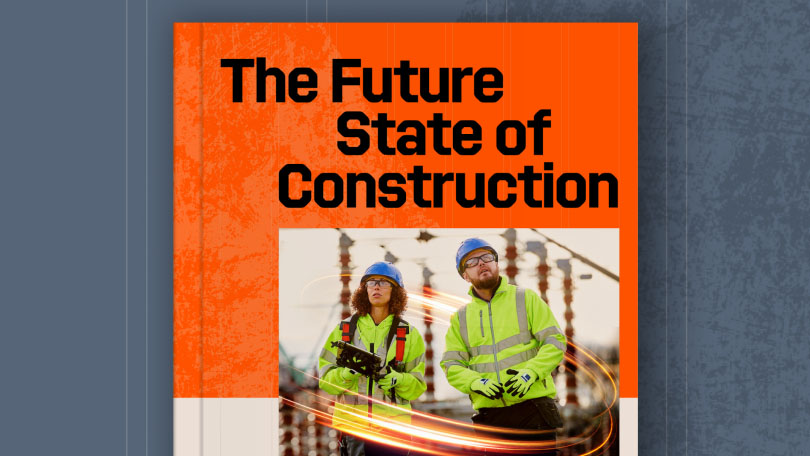— 5 min read
Construction Documents: The Path to Project Success

Last Updated Aug 28, 2025

Nicholas Dunbar
Content Manager
62 articles
Nick Dunbar oversees the creation and management of UK and Ireland educational content at Procore. Previously, he worked as a sustainability writer at the Building Research Establishment and served as a sustainability consultant within the built environment sector. Nick holds degrees in industrial sustainability and environmental sciences and lives in Camden, London.

Zoe Mullan
27 articles
Zoe Mullan is an experienced content writer and editor with a background in marketing and communications in the e-learning sector. Zoe holds an MA in English Literature and History from the University of Glasgow and a PGDip in Journalism from the University of Strathclyde and lives in Northern Ireland.
Last Updated Aug 28, 2025

Construction projects are more than just materials and labour. They’re built on precise documentation that helps to keep everything running smoothly. Think of construction documents as the project’s operating system - connecting architects, engineers, contractors, and clients.
Table of contents
What Are Construction Documents?
Construction documents are the paperwork that defines a build. They include:
- Design plans
- Technical specifications
- Cost estimates
- Project records
These documents align everyone's understanding of the project’s scope, requirements, and execution while facilitating compliance with legal and industry standards.
Why Construction Documents Matter
Good documentation is the unsung hero of successful construction projects. It reduces errors by eliminating ambiguity, improves communication across diverse teams, prevents potential legal disputes, and ensures consistently high-quality outcomes.
Construction compliance is particularly stringent in the UK, with documentation playing a key role in legal protection. The Building Safety Act 2022, implemented after the Grenfell tragedy, has made record-keeping and document control more important than ever, particularly for high-risk buildings.
Digital vs. Paper-Based Documentation
Outdated or conflicting versions is one of the biggest risks in construction documentation. Mistakes can result in delays, cost overruns, or compliance failures.
The UK construction industry has generally embraced digital documentation, driven by the government’s BIM Level 2 mandate for public projects. But smaller firms sometimes rely on paper-based systems and challenges remain in achieving full digital integration across the industry.
Digital documentation and cloud-based document management platforms streamline construction workflows and let everyone work on the latest version. They include:
- Real-time updates
- Automated version tracking
- Access control
While legal contracts and site permits may still require paper copies, digital document management makes project management faster, more efficient, and less error-prone.
Learn about the future of the built environment - Read Procore's Future State of Construction report
Learn how contractors, subcontractors, and project teams can take advantage of new opportunities to boost efficiency and profitability over the next decade. Download the report to get your roadmap to the future state of construction.

Key types of construction documents
Legal and Contractual Documents
These establish the project's legal framework:
- Construction Agreement: Formal contract defining project scope, costs, and legal terms between the owner and contractor
- Scope of Work (SOW): Detailed document specifying project tasks, deliverables, and quality expectations
- Change Orders: Official records of contract modifications, including budget and timeline adjustments
- Request for Information (RFI): Document to clarify design details, specifications, and other contract-related matters
Design and Technical Documents
These provide the project's visual and technical details:
- Drawings and Blueprints: Architectural plans showing dimensions, materials, and spatial arrangements
- Issued for Construction (IFC) Documents: Final, approved drawings for on-site implementation
- Specifications: Technical descriptions of materials, methods, and performance requirements
Financial Documents
These track and manage project costs:
- Bill of Quantities (BOQ): Detailed breakdown of materials, labour, and equipment costs
- Cost Estimates: Financial projections from preliminary to final project stages
- Schedule of Values: Document work items and their associated costs for progress payments
Project Management Documents
These help plan and track progress:
- Construction Schedule: Timeline of project milestones, start/end dates, and task dependencies
- Work Breakdown Structure (WBS): Hierarchical breakdown of project tasks and deliverables
- Submittals and Approvals: Formal reviews of materials, plans, and compliance measures
Construction Plan: The Project’s Master Document
A construction plan pulls everything together in a single, comprehensive strategy. It covers:
- Project objectives
- Task breakdown
- Budget control
- Project timeline and milestones
- Material and resource planning
- Health and safety compliance
Construction Plan vs. Construction Schedule
These documents are often used interchangeably, but they serve different purposes:
| Construction Plan | Construction Schedule |
| A strategic project roadmap | A timeline-driven document |
| Covers scope, budget, safety, and execution strategies | Covers task sequencing, start/end dates, and dependencies |
| Defines who does what and how work should be executed | Defines when each activity happens |
| Used throughout the project lifecycle | Adjusted as project timelines shift |
Construction Documents in Project Phases
Construction projects follow a structured lifecycle, from design to completion. Documents slot into these project phases:
Design Phase
During this phase, teams focus on project feasibility, initial designs, and regulatory compliance before moving to bidding and procurement. Documents include:
- Architectural Drawings and Blueprints: Early design concepts outlining project vision
- Specifications: Technical material descriptions and performance requirements
- Site Surveys and Reports: Documents assessing environmental conditions, land topography, and potential risks
- Zoning and Permitting Documents: Paperwork to ensure compliance with local building codes and planning regulations
Bidding and Contracting Phase
During bidding, construction documents help contractors price projects accurately and ensure legal agreements are in place. They include:
- Bid Package (Tender Documents): Drawings, BOQs, and contractor pricing specifications
- Cost Estimates and BOQs: Provide a breakdown of materials, labour, and project expenses
- Requests for Information (RFIs): Clarify design uncertainties before finalising contracts
- Construction Agreement and General Conditions: Establish formal contracts, payment terms, and legal obligations
Construction Phase
During construction, documents focus on progress tracking and quality control, including:
- Issued for Construction (IFC) Drawings: Approved plans used by on-site contractors
- Variation Orders: Official modifications to scope, budget, or materials
- Construction Schedule and WBS: Outlines project timeline, task dependencies, and milestones
- Submittals and Approvals: Formal materials, equipment, and compliance standards review
- Safety and Compliance Reports: Maintain rigorous health, safety, and environmental standards
Project Closeout Phase
During this phase, construction documents check that all work meets contractual, regulatory, and quality standards before handover:
- As-Built Drawings: Updated blueprints reflecting changes made during construction
- Final Inspection Reports: Certifying that a project meets compliance and quality benchmarks
- Warranties and Maintenance Manuals: Providing maintenance guidance for installed systems and equipment
- Punch List: A minor fixes checklist required before project completion
UK construction contracts and documentation is often complex and may include JCT (Joint Contracts Tribunal) contracts and New Engineering Contract (NEC) forms, requiring strict procedure documentation.
Final Thoughts
Construction documents are the backbone of successful building projects. They transform complex construction challenges from potential chaos into carefully organised success. Investing time in creating clear, comprehensive documentation sets a project up to run smoothly from start to finish, ensuring precision, reducing risks, and maintaining high quality and compliance standards
Categories:
Written by

Nicholas Dunbar
Content Manager | Procore
62 articles
Nick Dunbar oversees the creation and management of UK and Ireland educational content at Procore. Previously, he worked as a sustainability writer at the Building Research Establishment and served as a sustainability consultant within the built environment sector. Nick holds degrees in industrial sustainability and environmental sciences and lives in Camden, London.
View profileReviewed by

Zoe Mullan
27 articles
Zoe Mullan is an experienced content writer and editor with a background in marketing and communications in the e-learning sector. Zoe holds an MA in English Literature and History from the University of Glasgow and a PGDip in Journalism from the University of Strathclyde and lives in Northern Ireland.
View profileExplore more helpful resources

Control the Chaos: Standardising Document Workflows in Construction Projects
Document control and implementation play a central role in managing risk, meeting deadlines, and delivering projects to spec. As builds become more complex and teams increasingly disperse, the volume and...

Cost-Plus Construction Contracts in the UK
A construction cost-plus contract – sometimes called a cost-reimbursable or prime cost contract – reimburses all project costs and adds a fee to cover the contractor’s overhead and profit. UK...

Digital Construction Technology for Whole-Life Value
For decades, the construction industry has kept a narrow focus on capital cost — the one-time, upfront costs of a construction project. While in the short term this seems like...

UK Construction Progress Reports: Tools for Smarter Site Management
Construction progress reports track completed work, on site issues, costs, and safety so UK project teams can demonstrate progress, secure payments, and stay on programme. Accurate progress data is essential...
